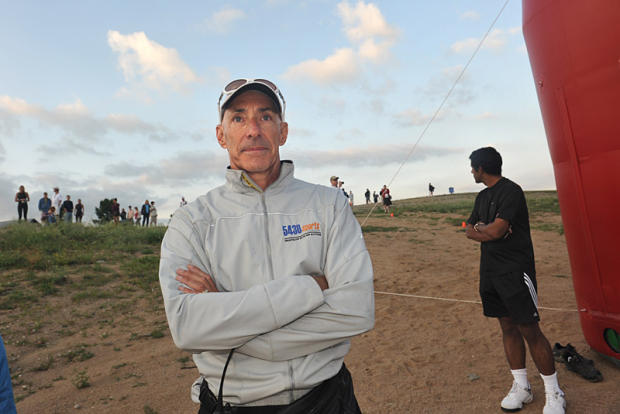It Was a Dark and Stormy NGB
Scratch the skin of one of the prosperous sports organizations under the USOC umbrella. Just underneath is a tangle of recent lawsuits, hearings and arbitrations generating legal fees that are, by some estimates, deep into the six figures. These represent only the fees USA Triathlon is responsible for paying, and they might go much higher if USAT's legal opponents are successful in winning judgments as well as payment of their own legal fees.
These aren't actions by or against outside interests, rather USAT's own actions against current or former USAT board members, as well as actions by board members and elite athletes against USAT. These are not only expensive for all participants, they're exhausting the staff and volunteers according to those to whom I've spoken, most of whom are fearful of talking, or of having their names attached to their quotes. Intramural actions like these aren't covered by USAT's Directors & Officers insurance.
Board members now closely parse the words for fear of lawsuits against them. They are often averse to sending emails, for fear of having to turn them over to opposing board members looking for incriminating or embarrassing correspondence. They do their talking to me mostly on the telephone, restricting email to perfunctory correspondence. They establish ground rules for interviews in advance. Sometimes they ask if the conversation is recorded.
The two sides in what is now an open and expensive conflict are characterized thusly by the author of Jarrod Shoemaker's suit against USAT, filed just last week (Jarrod Shoemaker vs. USA Triathlon). The complaint reads: "Throughout the entire 2013 election process, and continuing to this day, the majority of the USAT Board of Directors has expressed open hostility to the class of 'elite athlete' members of USAT, preferring instead to cater to the interests of the class of race directors and the class of age group (recreational) triathletes."
For at least the last 10 years there's been a split on USAT's board between a majority of "general directors" versus the "elites." There are 12 members comprising USAT's board (excluding "ex officio" board members), 8 of whom are general directors (voted in by membership of each of 8 regions); 3 of these 12 are elite representatives, voted in by their peers through a process primarily prescribed by the USOC. One "independent director" is chosen by the Board. The Board's current president is the Barry Siff (pictured below) of Boulder 5430 fame.

This tension between cohorts is understandable, because each constituency has its own wants. These conflicts boiled over in 2004 when those on or running for the Board sued one another and the Federation, generating hundreds of thousands of dollars in legal fees USAT was obligated to pay (and did pay). The USOC, along with other USAT members not on the Board at the time, stepped in and provided a new framework for moving forward. For the last half of the decade of the 2000s there was relative comity on the Board.
USA Triathlon is much richer, larger, and more powerful today than during the fracas a decade ago. It enjoys annual revenues of $16 million or so, certainly in the top-10 in revenues and financial health among the 45 or so federations the USOC recognizes under the Olympic umbrella, maybe in the top-6. It helped develop the current women's World Triathlon Champion and the second-ranked athlete as well. USAT's Age Group National Championships are at least fivefold larger than a decade ago. On paper – in no small part because of the volunteer board guidance – USAT couldn't appear healthier.
USAT Politics Has Been Good for the Legal Profession
But the 2004 fight has flamed up again, embroiling current and recent members of its board. Over the last 18 months there have been 3 lawsuits brought by elite athletes (one of the athletes a board member) against USAT, and 1 lawsuit by USAT in response, and at least a half-dozen governance-related Hearings & Appeals Panels, or arbitrations, instigated by or against sitting or former board members, with more cases against yet more in governance begun or contemplated.
Also, the USOC has hired its own lawyer in California to investigate USAT's internecine legal war, on top of a number of hearings and arbitrations that both the USOC and the USOC's athlete council have undertaken to investigate or resolve USAT's war with itself (all to no avail as of this writing).
When USAT's board brings a Hearing & Appeals case against a member it's a potent tool in the chest. This device – embedded in USAT's bylaws as a remedy for breaking USAT's Code of Conduct – empowers USAT with the ability to terminate membership in USAT. There is no method in the Bylaws for voting a board member off and there shouldn't be; board members serve at the pleasure of their constituents, and only their constituents can remove them from the Board. But a board member must be a USAT member in good standing, so if he's stripped of his membership he is ineligible to continue in his position on the board (denial of annual membership can also keep a prospective candidate from running for the Board).
Critics of USAT's use of these hearings claim that it's an abuse of power by a board that has vast financial resources, with the board majority using the organization's money to harass opponents while they themselves are insulated and protected from countersuits by USAT's deep financial reserves. Those who defend the use of these hearings claim it's the only method available to resist the mischief and harm perpetrated by a recalcitrant member.
These latest criss-crossing lawsuits and hearings can be traced back to a realignment of the Board in 2012, even more so to bad blood from the ITU Congress in 2012 in Auckland. At these Congresses every country sends delegates and can forward nominations for ITU Executive Board positions. The U.S. chose to nominate Elizabeth Farnan for consideration for the E-Board. This was considered a blow to the elite cohort on USAT's board; it wanted Melissa Merson. There's a strategic reason to want Ms. Merson reelected to the ITU board (she had been on the E-Board since 2008). She was a close confidante of ITU President Marisol Casado. Ms. Merson would have cast USAT's vote for Ms. Casado, who was up for reelection herself. Ms. Merson is a champion of the Olympic movement and is usually a reliable vote for elite initiatives.
It was likely Ms. Merson would end up on the ITU's executive board again were she the U.S. nominee, and if that did occur she would be not only an ITU board member but, per USAT's bylaws, also a USAT board member "ex officio". Some on USAT's board maintain that Ms. Merson just was not a fit nominee, that Ms. Farnan was the better choice, even if Ms. Farnan was less likely to win election to the ITU E-Board. That was the prevailing view of a majority of the board, and Ms. Farnan was selected as USAT's nominee for the ITU E-Board in Auckland.
USAT back and voted for a candidate other than Ms. Casado in that election. Ms. Casado won, resulting in the end of Ms. Merson's stint on the ITU's executive board.
Coming Home to a Place He'd Never Been Before
USAT's Board had been trying to move the Federation to Colorado since 2007. The membership was asked to move the Federation to Colorado, which required a series of votes of the membership, all of which passed. But nagging delays kept USAT in California until 2012.
But the move to Colorado suddenly, in 2012, became a point of contention on the Board. Elites have been fighting, ardently, since 2012 to keep USAT in California and that might seem strange, since the USOC and elite infrastructure based on Colorado Springs was in every way a benefit to elites. They weren't against moving the office to Colorado Springs, as long as USAT stayed a California corporation. Why?
USAT's bylaws designate that the most recent former board president, as well as any ITU executive committee members, were ex officio board members of USAT. But, per those bylaws and as a result of a bylaw change in 2008, ex officio board members had no voting power and could not attend a meeting unless they were invited by USAT's Board. For much of this time Ms. Merson was a member of the ITU E-Board starting back in 2008, she was often not offered, by the board majority, an invitation to USAT's board meetings.

But in October of 2012 it was brought to the USAT board's attention that in 2010 California passed a law that imbued all ex officio board members of nonprofit boards the right to vote and to be heard in meetings. The unearthing of this legal nugget (overriding USAT's Bylaws) called into question the legitimacy of all votes where Ms. Merson was not allowed to vote.
Further, if Ms. Merson was imbued with all the rights of a USAT Board member, would this raise the functional number of board members from 12 to 13? That is a legal question on which not everyone agrees. Still, if so, might this trigger the need for another elite board slot, as 3 out of 13 falls below the 25 percent elite requirement enshrined into USAT's bylaws back in 2012? Further, would this trigger an analysis of all board votes since the beginning of 2010, when the California change became law?
Beginning in the Autumn of 2012 alarm bells went off, and the organization's situs move from California to Colorado – and the opposition to it – shifted into high gear.
Steven Sexton, Elite Athlete, Citizen Lawyer
In early 2013 an elite representative on the Board, Steve Sexton (image above), filed suit in California court. He had asked USAT for a trove of emails between board members – thousands by one estimate, certainly hundreds – as well as a digital version of USAT's membership. USAT refused both. After a year of litigation in Los Angeles County Superior Court the judge awarded Mr. Sexton the right to the emails, which he received. Mr. Sexton wrote me in March of this year, "Sexton v. USAT was about my access to records which the law guarantees me as a director and which our bylaws guarantee me as a member. USAT fought my access to records – and lost."
Mr. Sexton won that part of his suit. The court did not grant him access to a digital file of USAT's members.
"The question," wrote Mr. Sexton wrote to me in March, "is why they [USAT] fought? We may soon know as I gain access to the records."
Mr. Sexton had a pretty good inkling of why the Board majority fought, and it's probably why he brought the suit in the first place, which we'll explore in tomorrow's installment.

